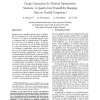Free Online Productivity Tools
i2Speak
i2Symbol
i2OCR
iTex2Img
iWeb2Print
iWeb2Shot
i2Type
iPdf2Split
iPdf2Merge
i2Bopomofo
i2Arabic
i2Style
i2Image
i2PDF
iLatex2Rtf
Sci2ools
ICS
1993
Tsinghua U.
1993
Tsinghua U.
Graph Contraction for Physical Optimization Methods: A Quality-Cost Tradeoff for Mapping Data on Parallel Computers
Mapping data to parallel computers aims at minimizing the execution time of the associated application. However, it can take an unacceptable amount of time in comparison with the execution time of the application if the size of the problem is large. In this paper, first we motivate the case for graph contraction as a means for reducing the problem size. We restrict our discussion to applications where the problem domain can be described using a graph (e.g., comput ational fluid dynamics applications). Then we present a mapping-oriented Parallel Graph Contraction (PGC) heuristic algorithm that yields a smaller representation of the problem to which mapping is then applied. The mapping solution for the original problem is obtained by a straight-forward interpolation. We then present experimental results on using contracted graphs as inputs to two physical optimization methods; namely, Genetic Algorithm and Simulated Annealing. The experimental results show that the PGC algorithm still l...
Distributed And Parallel Computing | Execution Time | Graph Contraction | ICS 1993 | Mapping Solutions |
| Added | 09 Aug 2010 |
| Updated | 09 Aug 2010 |
| Type | Conference |
| Year | 1993 |
| Where | ICS |
| Authors | Nashat Mansour, Ravi Ponnusamy, Alok N. Choudhary, Geoffrey Fox |
Comments (0)

